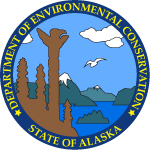| Action Date |
Action |
Description |
DEC Staff |
| 11/1/2012 |
Update or Other Action |
Email correspondence AUKE BAY LABORATORY NMFS/AKFSC/ABL Maintenance Mechanic - Tom Abbas [NOAA/NMFS PO Box 2530 Little Port Walter Sitka AK 99835 907-723-4457] to ADEC PERP Crystal Smith:
Crystal: I've attached some documents and photos of the site.
Answering your questions - All of the residential lines have been removed some time ago. Fuel was observed in the soils surrounding and inside the abandoned electrical conduit we were removing in the areas noted. The pressure test that failed was on the only remaining underground fuel line on site which feeds the Generator shed. This line is approximately 98ft long and is now a double wall polymer pipe.
The original was black iron with magnesium anodes cad welded to it. The photos of the corroded pipe and evidence of fuel are the old pipe I replaced this spring. The photo with the
green liquid(#2 diesel) was taken during the line replacement and was at the low point of the line at a cad weld for the magnesium anode. My assumption is that condensation had settled there and precipitated the corrosion.
Only a small amount of fresh fuel- less than a gallon was noted at this point and presumably opened when uncovered and the wire for the anode was moved. This line would not pass the annual air pressure test showing a very slow pressure drop. The vast majority of contamination was well above the buried fuel line and seemed to originate from the Generator shed. All fuel lines there were inspected and no discrepancies were noted. Suspect that historic spills occurred inside the Generator shed or from old lines.
As noted above I don't suspect the low point hole on the fuel line was much of an issue until uncovered as there was advanced corrosion and severely degraded anodes throughout the installation as noded in the photos. Every effort was made to absorb, remove and clean up fuel, old and new from the excavations as I uncovered them. My intentions with contacting the DEC where to have some official record of these findings so we can formulate a clean up plan and goal. Thank you for your assistance with this registry.
Regards
Tom |
Louis Howard |
| 11/1/2012 |
Underground Storage Tank Site Characterization or Assessment |
Email from ADEC PERP to NOAA:
Tom,
Thank you for this document. I have a few other questions in regards to the report that you made
to our contaminated sites program. In that report you state that you have been digging around
the property to replace lines that bring heating fuel to the residences and that these lines are
being replaced due to the old ones failing a pressure test.
When was the pressure test conducted on these lines?
Has the replacement of the lines been conducted this year?
When replacing the lines have you noticed any holes or leaks in the lines?
Any additional information that you can give me on the replacement of these lines will help me. |
Louis Howard |
| 11/23/2012 |
Potentially Responsible Party/State Interest Letter |
Certified letter from Crystal Smith sent to NOAA Alaska Fisheries Science Center National Marine Fisheries Service - NOAA Attn: Douglas DeMaster 7600 Sand Point Way NE, Building 4 Seattle, WA 98115 from ADEC # 7003 0500 0004 7870 8768 RE: Little Port Walter Hatchery Contamination, Spill# 12119930401 from SPAR PERP Juneau AK.
This letter is to advise you that prior to October 30, 2012 a pollution incident or incidents occurred at your property at the Little Port Walter Hatchery on Baranof Island near Sitka, Alaska. You may be financially responsible for this incident. It was reported to this Department on October 30, 2012, that underground fuel lines running to the generator shed failed a pressure test this past spring.
When these lines were replaced contaminated soil was found and the lines showed signs of
corrosion. In addition, when other excavation work has been done on the property large amounts of contaminated soil have been found. It has been estimated that the contamination is spread over a one-quarter of a mile by one-quarter of a mile area.
Alaska Statute Title 46 authorizes the State to respond to this pollution incident and to take
appropriate action to minimize damages to human health, safety or welfare or to the environment.
Under Title 46, the owner or operator may be held financially responsible for any actions taken by the State. If you undertake response actions, they must be approved in advance by the Department under 18 AAC 75.300 - .396, and the adequacy of those actions will be evaluated by Crystal Smith, the Project Manager for this pollution incident. Response actions are adequate if they accord with state and federal law, including 18 AAC 75.
If you are taking adequate actions, State action will be limited to approving cleanup plans,
monitoring the progress of cleanup activities and providing guidance as necessary. Alaska Statute 46.08.070 requires that recovery be sought for certain costs, including oversight activities, incurred by the State in responding to pollution incidents. If you are determined to be a responsible party, the State may bill you at a later date for State expenditures associated with this pollution incident.
Billable State expenditures include the direct costs of State staff time and indirect State overhead costs, as well as contractual and materials costs. Billable State staff time includes all time spent on activities related to the incident, including site visits, response and report reviews, telephone conversations, meetings, legal services, and interest.
If you believe someone else may be responsible for this pollution incident or if you have any
questions concerning this matter, please contact me at 907-465-5346
Sincerely
Crystal Smith |
Louis Howard |
| 11/23/2012 |
Enforcement Action |
Notice of Violation Sent to AK Fisheries Science Center National Marine Fisheries Service – NOAA Attn: Douglas DeMaster 7600 Sand Point Way NE, Building 4 Seattle, WA 98115 Re: Little Port Walter Hatchery Contamination, Spill # 12119930401.
ADEC alleges that prior to October 30, 2012, at the LPW Hatchery, on Baranof Island, AK; the AK Fisheries Science Center of NOAA had numerous petroleum discharges that went unreported to ADEC & have not been contained or cleaned up. Such actions are in violation of AS section 46.03.740 which states that a person may not discharge, cause to be discharged, or permit the discharge of petroleum into, or upon the waters or land of the state & AS section 46.03.755 which states a person in charge of a facility as soon as the person has knowledge of any discharge from the facility in violation of AS 46.03.740, shall immediately notify ADEC of the discharge. These actions are also in violation of AS section 46.04.02 (a) which states that a person causing or permitting the discharge of oil shall immediately contain & clean up the discharge.
The CS Program was notified on October 30, 2012 about contaminated soil that was found at the LPWH facility. It was reported that there were a number of ‘historical’ spills on the site & that contamination was found while digging up conduit & replacing fuel lines on the property. While investigating this matter, ADEC discovered that the fuel lines running to the generator shed at the facility failed a pressure test last spring. Following the failure of this test the fuel lines were replaced. During the replacement of these lines, contaminated soil was discovered along with corroded fuel lines.
This discovery was not immediately reported to ADEC as required. In addition, other excavation work at the site has discovered an extensive amount of contaminated soil from previous discharges. ADEC has no records of any discharges having occurred at the LPWH. To ADEC’s knowledge there have been no efforts made to clean up the contamination at this facility.
To address the violations described above, ADEC requests that you do the following:
Provide a copy or copies of the pressure tests on the fuel lines which were removed this past summer & include what actions were taken on the failure of the pressure test including the date the fuel lines were replaced.
Provide any photographs taken during the replacement of the lines & reports generated describing the replacement project & the condition of lines when removed during the excavation.
Explain the circumstances surrounding the failure to report in writing by December 14, 2012;
Conduct a complete site assessment of the property to determine the extent of the contamination. This site assessment must be conducted by an independent third party. A report of this site assessment must be submitted to ADEC in writing when completed. Please provide an expected start date for the assessment by December 31, 2012;
For additional information see site file. |
Louis Howard |
| 12/11/2012 |
Update or Other Action |
NOAA NMFS AK FSC Seattle WA response to C Smith NOV sent on LPW Hatchery.
RE: November 23, 2012 Notice of Violation, Little Port Walter Hatchery #12119930401
Enforcement Tracking: 12-1351-50
This letter constitutes the formal response of NOAA, National Marine Fisheries Services, AK Fisheries Science Center (AFSC) to the November 23, 2012 ADEC Notice of Violation (NOV) cited above. The NOV alleges that prior to October 30, 2012 a pollution incident or incidents occurred at the AFSC Little Port Walter Hatchery (LPW) on Baranof lsl&, AK. It is the NOAA AFSC position that there have been no violations of AK Statutes Title 46 (AS 46) or under AK Administrative Code Chapter 18 section 75 (18 AAC 75.300- 75.396). It is our further position that in alleging these violations, ADEC has relied on anecdotal information from AFSC maintenance personnel, rather than seeking environmentally & technically accurate information from AFSC environmental management personnel as would normally be expected.
The LPW facility is a remote laboratory campus on the south end of the Tongass National Forest on Baranof lsl&, approximately 140 miles south-southwest of Juneau Alaska. The site is self- contained consisting of ten buildings supporting a fish weir, fish pens in a float system, laboratories, support shops, & residences for the personnel working there. The normal complement is two caretakers & their• families & during the summer up to 12 scientists & researchers. The site was chosen for Fisheries research because of the access to pristine fresh & salt water. The facilities are powered by three generators, one of which is running at all times to provide power to the station. The buildings have day tanks (100 - 300 gallons) for the fuel used for heating. There is bulk storage of number two diesel fuel in an 11,400 gallon tank upgrade from the warehouse & wet lab buildings.
The bulk tank is filled three times a year from a vessel that is brought into the harbor. The generators are fed by a day tank which is fed by a buried pipeline from the bulk tank. The remaining day tanks are filled by using a portable tank to transport the fuel from the bulk tank to the building. There is the potential for de minimis spillage during fuel transfers between tanks but the equipment is designed to account for & minimize these spills & the personnel involved have cleanup materials to deal with these incidental spills when they happen.
To further NOAA's position as steward of the environment, LPW upkeep & maintenance is designed to ensure the area remains pristine & the facility remains a place that continues to yield credible & sustainable scientific data. All equipment maintenance is accomplished inside the warehouse on a concrete surface where any potential fluid spill can be rapidly & completely recovered. Equipment refueling is done with drip pans & absorbent pads beneath the point of fill to eliminate soil contamination from any incidental overfill or drips.
Since the NMFS has occupied the LPW facility there has been only one spill that has exceeded a reportable threshold outlined in AAC 18. That spill occurred in March of 1980 & was reported to the Coast Guard, the Tongass National Forest Supervisor & the Alaska Department of Environmental Conservation on March 4, 1980 under then current regulations, & was remediated in full conformity with all applicable laws & regulations.
For additional information see site file.
|
Louis Howard |
| 2/7/2013 |
Update or Other Action |
Spill transferred by PERP staff Crystal Smith. Spill no. 12119930401; spill date = 10/20/12; substance = diesel; quantity = unknown; source = multiple historic releases. |
Mitzi Read |
| 2/8/2013 |
Spill Transferred from Prevention Preparedness and Response Program |
Letter from PERP to NOAA/NMFS.
National Marine Fisheries Service - NOAA Attn: Jay Kennedy 7600 Sand Point Way NE Bldg 4
Seattle, WA 98115
RE: Notification of Intra-Department Project Management Transfer, Little Port Walter Hatchery Contamination, Spill # 12119930401
The Department is notifying you of the transfer of project management responsibility for this spill from the Prevention and Emergency Response Program (PERP) to the Contaminated Sites (CS) Program.
This spill occurred at Little Port Walter Hatchery on Baranof Island near Sitka, Alaska. Based on the historical nature of the contamination I am transferring the case to CS for long term monitoring.
Please call me at (907)465-5346 if you have questions or comments regarding this letter.
Crystal Smith, environmental program specialist, project manager |
Louis Howard |
| 2/11/2013 |
Site Added to Database |
A new site has been added to the database |
Mitzi Read |
| 5/9/2016 |
Update or Other Action |
Spoke to NOAA/NMFS project manager, he is working on getting funding for next year to investigate the site. |
Louis Howard |
| 11/8/2016 |
Update or Other Action |
Work plan for environmental liabilities evaluation received for review & comment.
The five specific project objectives identified are:
1. Investigation of soil around present & historical fuel system infrastructure to confirm the presence or absence of petroleum hydrocarbon contamination in soil. Analytical soil samples will be collected & analyzed to document current conditions.
2. Investigation of painted structures to verify presence or absence of lead based paint (LBP). Paint chips & proximal soil samples will be collected & analyzed to determine the extent of lead contamination if LBP is present.
3. Determination using mercury vapor analyzers in areas within buildings or structures where thermometers &/or manometers were used & stored. The collection & analysis of porous materials will be conducted if mercury is present.
4. Visual inspection & identification of twelve building structures potentially constructed of treated lumber. Surrounding soils of identified potentially treated lumber will be collected & analyzed for contamination related to wood preservation chemical treatment. If water is encountered during soil sample collection, water samples will be collect & analyzed for the same constituents for the purpose of information gathering only.
5. Review & confirm the information on location, quantity, & condition of ACM identified in the 1996 Asbestos & PCB Survey Report. Ahtna will collect samples of previously non-sampled homogenous areas & identify ACM that has deteriorated or become friable.
See site file for additional information. |
Louis Howard |
| 11/17/2016 |
Document, Report, or Work plan Review - other |
Staff provided comments on the Draft work plan.
Main comments were regarding use of the correct Over 40 Inch Zone 11/6/16 cleanup levels from the tables for many contaminants listed in the document. Other comments were made regarding including copper during analysis when pressure treated wood products are being investigated and use 30 feet as the distance for assessing vapor intrusion pathway for any occupied buildings and contaminant sources in soil or groundwater.
See site file for additional information. |
Louis Howard |
| 8/11/2017 |
Offsite Soil or Groundwater Disposal Approved |
Soil transport form signed for transport of soil to Bicknell facility in Juneau from Little Port Walter NOAA research station. |
Louis Howard |
| 12/19/2024 |
Update or Other Action |
Site transferred to new project manager, Jennifer McGrath. |
Jennifer McGrath |




